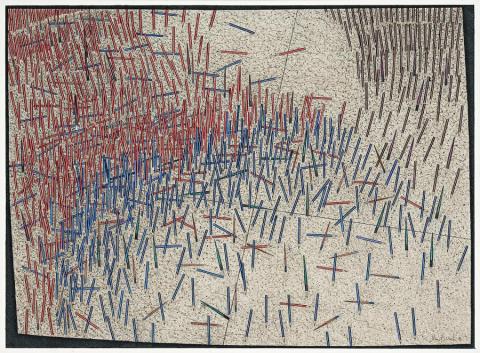BATTLE, 1981
John Brack
watercolour, pen and ink on paper
71.0 x 96.0 cm
signed and dated lower right: John Brack 81
Private collection, Melbourne
John Brack, Tolarno Galleries, Melbourne, 21 May – 11 June 1983
Grishin, S., The Art of John Brack, Oxford University Press, Melbourne, 1990, vol. I, p. 156, vol. II, cat. p. 281, p. 72
The Battle, oil on canvas, 203.0 x 274.0 cm, collection of the National Gallery of Australia, Canberra (Grishin, o269)
'When Brack's monumental Battle 1981-83 was first unveiled at the Tolarno Galleries, Melbourne in May 1983, the reviews were overwhelmingly positive. Memory Holloway, art critic for the Melbourne Age proclaimed the work 'one of the most important pictures painted in Australia over the past five years', while Robert Rooney, critic for The Australian, considered the composition 'a rich tapestry of superbly organised order and disorder as one of history's war games is played with comic precision by opposing armies of optically dazzling pens and pencils - the instruments of his profession.'1 Dating from 1980-81, the present watercolour notably relates to the celebrated painting while, at the same time, constituting an important work in it own right.
Occupying Brack for over three years, the theme of the 'battle' was inspired primarily by the artist's own experiences as an artillery officer during the war, from which he had concluded that it was impossible to render a battle convincingly in art. 'One could either paint a single event very close up, like an exploding shell blowing people into horrible mutilated fragments, or alternatively paint a very general view where the reality of the battle would be totally lost. When he was in Europe and saw at first hand some of the famous battle paintings, he felt these observations were confirmed... Besides the challenge which this theme presented in terms of its formal language, it was also a culmination of many of Brack's conceptual concerns in his pencil series. It implied an ironic perception of history and a comment on the futility of military campaigns. The battle as a metaphor for conflict within society is also a universal theme in the age of anxiety...'2
As Helen Brack elaborates,'...The Battle 1981 is a description of the strategic ability of Humankind, of the intelligence, and equally of the barbarism - not to be neglected or discounted, always present, waiting to become active. The battle of Waterloo was used because of the pitting together of two mighty strategists of equal calibre, not the strong over the weak. The subject explores man's organising ability and his drive for conflict - but in such conflict there is always the killer instinct, our animal dimension that is not to be dismissed. In this drawing that precedes the painting, John has configured in the line of clash between the blue French and the red English, the image of a dinosaur-like creature, almost a shadow, that starts on the left side of the rectangle, curving round to the right side; the head of the creature, complete with pencil eye, near the lower center of the rectangle. In the painting, this was made clearer, indeed, was specifically indicated in the underpainting of the picture. This same device of configuration was used in Procession 1979-80 and then, to mention but a few, in Yes, No 1983-84; No 1984; Now and Then 1986, and Tower 1985.
Here, the pens represent the officers and the pencils, the soldiers. On the ground are the marks made, then and in the past, of our doing, marks of trailing, of stabbing, and a dense mesh of ever living and breathing that covers, with regularity, over the whole ground. As always in John's later works, the scene is as it were cut out and placed on top of the larger ground of the picture rectangle. Underneath, is a dense dark aerated abyss, from which the black straight lines of the floor division emerge. John has made sure the viewer will see this abyss by defining the very dark edge that meets the light ground of the scene. It is interesting that the pens and pencils flow from the abyss, do not commence at the performance ground level, and leave, into the abyss. Underlying the whole composition is a regular, very fine mesh of lines, on top of which are trailing unbroken lines and different kinds of splats and smudges. Perhaps these trailing lines on the ground, against the hard black lines of the ground plan, also indicate the ruled framework that enclose our trailing wandering individual lives.'3
1. Grishin, S., The Art of John Brack, Oxford University Press, Melbourne, 1990, vol. I, p. 163
2. Ibid., pp. 152-4
3. Brack, H., 'Essay on Battle 1981', Melbourne, 2010
WE ARE GRATEFUL TO HELEN BRACK FOR HER ASSISTANCE WITH THIS CATALOGUE ENTRY
